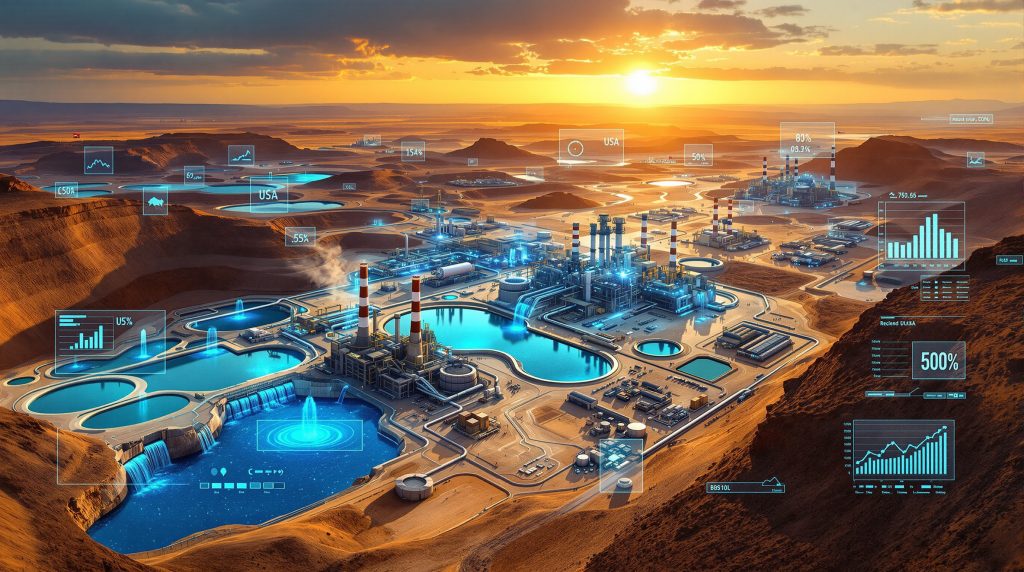The Hydrological Reality Behind Green Technology
Water scarcity represents one of the most critical challenges confronting the rare earth mining sector as global demand for clean energy technologies accelerates. The environmental paradox becomes increasingly evident: minerals essential for renewable energy infrastructure require massive water consumption during extraction and processing operations. This challenge intensifies as many of the world's largest rare earth deposits exist in regions experiencing severe water stress.
The mining industry faces an unprecedented situation where the materials needed for environmental solutions create their own environmental constraints. As governments worldwide push for energy transitions and carbon reduction targets, understanding the water-mining nexus becomes crucial for sustainable resource development. Furthermore, modern mine planning must increasingly account for water availability alongside traditional geological factors.
Understanding the Extreme Water Demands of Rare Earth Processing
Rare earth element extraction ranks among the most water-intensive industrial operations globally. Processing facilities typically require between 200 and 1,500 cubic meters of water per ton of rare earth elements produced, depending on the extraction methodology and ore characteristics employed at each site.
The Six Primary Water-Consuming Operations
The water intensity stems from multiple simultaneous processes that cannot easily be reduced:
- Chemical leaching operations requiring continuous water circulation for acid dissolution
- Flotation separation techniques that concentrate minerals through density differences
- Equipment cooling systems maintaining optimal temperatures during thermal processing
- Dust suppression systems across expansive mining sites
- Solvent extraction procedures for individual element purification
- Waste neutralization processes that prevent acid mine drainage
Regional Water Consumption Variations
Water usage varies significantly based on geographic location, ore grade, and processing technology:
| Mining Region | Average Water Use (m³/ton REE) | Primary Water Sources | Scarcity Classification |
|---|---|---|---|
| Inner Mongolia, China | 800-1,200 | Depleting groundwater | Critical shortage |
| California, USA | 400-800 | Colorado River allocation | High stress |
| Western Australia | 600-1,000 | Desalination plants | Severe constraints |
| Brazilian Cerrado | 300-600 | Surface water systems | Moderate pressure |
The variation reflects different processing approaches, ore grades ranging from 0.1% to 1% rare earth oxides, and local water availability conditions that directly impact operational costs.
Geographic Misalignment Creates Operational Vulnerabilities
The fundamental challenge facing the industry involves the geographic distribution of rare earth deposits in relation to water resources. Australia exemplifies this dilemma perfectly: abundant monazite and bastnäsite deposits exist primarily in arid regions where annual precipitation averages 100-300 millimetres, far below the 800+ millimetres typically needed to support industrial water demands.
Critical Vulnerability Factors
Desert mining regions face compounding water stress from multiple directions:
- Groundwater depletion: Aquifer levels declining 1-3 metres annually in major production areas
- Seasonal precipitation extremes: 60-80% variation between wet and dry periods disrupting operations
- Urban population growth: Municipal water demands increasing 3-5% annually in mining regions
- Agricultural competition: Irrigation requirements consuming 40-60% of available groundwater
Case Study: Inner Mongolia's Water Crisis
The Bayan Obo mining district in Inner Mongolia demonstrates the severity of water constraints in rare earth production. This region experiences annual precipitation of approximately 200 millimetres while supporting some of the world's largest rare earth operations. Local reports indicate accelerating groundwater depletion, forcing operations to drill progressively deeper wells at exponentially higher costs.
The situation creates a cascading effect where reduced agricultural productivity forces rural populations toward urban centres, increasing municipal water demands precisely where mining operations require massive industrial allocations. However, effective waste management solutions can help mitigate some of these environmental pressures.
Contamination Amplifies Water Scarcity Through Pollution Feedback Loops
Water contamination from rare earth mining operations creates a multiplier effect on regional scarcity by rendering previously usable water sources unsuitable for agriculture, municipal supply, or ecosystem support. This contamination-scarcity feedback loop represents one of the industry's most challenging long-term impacts.
Primary Contamination Mechanisms
Four distinct contamination pathways reduce total watershed water availability:
- Acid mine drainage releasing heavy metals and creating pH levels of 2-4 that persist for decades
- Radioactive tailings seepage from thorium-bearing monazite deposits affecting groundwater quality
- Chemical processing waste containing toxic solvents and separation agents
- Surface runoff contamination carrying suspended particulates and dissolved metals
Environmental Impact Progression
The contamination timeline demonstrates how water quality degradation compounds scarcity issues:
| Timeframe | Primary Water Effects | Cumulative Scarcity Impact |
|---|---|---|
| 1-2 years | Heavy metal concentrations exceed standards | 15-25% reduction in usable regional water |
| 3-5 years | Groundwater acidification spreads | 30-40% loss of agricultural water supply |
| 5-10 years | Ecosystem degradation becomes visible | 50%+ increase in treatment costs |
| 10+ years | Permanent aquifer contamination | Regional water security crisis |
The Baotou region in China provides a stark example of these impacts. The area's rare earth tailings pond covers approximately 11 square kilometres, with groundwater testing showing pH levels of 2-3 and heavy metal concentrations exceeding World Health Organization drinking water standards by 50-200 times in nearby wells.
Revolutionary Water Conservation Technologies Emerge
The industry responds to water constraints through technological innovation aimed at dramatically reducing consumption and improving recycling efficiency. These emerging solutions represent potential game-changers for sustainable rare earth production, though commercial scalability remains largely unproven.
Breakthrough Processing Technologies
Three primary technological approaches show promise for reducing water dependency:
-
Electrokinetic Extraction Systems
- Reduces traditional leaching agent consumption by up to 80%
- Decreases overall energy requirements by approximately 60%
- Concentrates rare earth ions through electrical field manipulation
-
Zero Liquid Discharge Facilities
- Achieves water recycling rates exceeding 95% efficiency
- Eliminates wastewater discharge through complete internal recycling
- Incorporates sealed waste stream management systems
-
Dry Processing Methodologies
- Eliminates water-intensive chemical leaching entirely
- Utilises advanced thermal and mechanical separation techniques
- Reduces environmental footprint through process simplification
Implementation Timeline Challenges
The Chinese Academy of Sciences has reportedly achieved significant breakthroughs in electrokinetic extraction, potentially reducing leach-agent use by 80% and energy consumption by 60%. However, scaling these innovations from laboratory to commercial production typically requires 3-5 years of pilot testing and demonstration projects.
Most breakthrough technologies remain in early development stages, creating a critical gap between current water demands and future conservation capabilities. This timeline mismatch means existing operations must continue relying on traditional water-intensive methods whilst newer technologies mature. In addition, reclamation innovation becomes crucial for addressing legacy water contamination issues.
National Water Management Strategies Diverge Significantly
Different countries approach water scarcity in rare earth mining through varying regulatory frameworks, investment strategies, and technological priorities. These national approaches reflect broader water security concerns and environmental policy objectives.
Comparative National Approaches
Australia's Comprehensive Strategy:
- Mandatory water recycling requirements for all new mining projects
- Significant investment in desalination infrastructure dedicated to mining operations
- Rigorous environmental impact assessments focusing specifically on water usage
- Development of zero-liquid-discharge facilities to leapfrog China's environmental legacy
China's Regulatory Crackdown:
- Strict limitations on water-intensive in-situ leaching operations
- Forced consolidation of smaller, inefficient mining operations
- Substantial investment in advanced processing technologies and R&D
- Tightened environmental regulations following decade of legacy contamination
United States Federal Initiatives:
- Direct federal funding for water-efficient mining research and development
- Public-private partnerships between mining companies and water utilities
- Regional water sharing agreements to optimise resource allocation
- National security considerations driving domestic processing capabilities
Investment and Effectiveness Metrics
| Country | Water Reduction Target (2020-2030) | Conservation Investment | Regulatory Stringency Level |
|---|---|---|---|
| Australia | 25% improvement | $2.1 billion AUD | Very High |
| China | 35% efficiency gain | $5.8 billion USD | Extremely High |
| USA | 18% consumption decline | $1.4 billion USD | Moderate-High |
| Brazil | 12% usage optimisation | $800 million USD | Moderate |
The investment levels reflect both the severity of water constraints and national priorities for developing domestic rare earth processing capabilities independent of Chinese supply chains. Consequently, Australia's green metals leadership positions the country well to address these challenges through innovative approaches.
Economic Impacts Reshape Industry Cost Structures
Water scarcity fundamentally alters the economics of rare earth mining through direct costs, infrastructure requirements, and regulatory compliance expenses. These changes create significant competitive advantages for facilities with superior water management capabilities. Furthermore, the Global Energy Transition faces increasing challenges as critical mineral extraction confronts water constraints.
Primary Cost Categories Affected
Water constraints increase operational expenses through multiple channels:
- Direct procurement costs: Water purchase, transportation, and treatment expenses
- Infrastructure investments: Advanced recycling systems, desalination plants, and storage facilities
- Regulatory compliance: Monitoring systems, environmental assessments, and community agreements
- Alternative technology development: R&D investments in water-efficient processing methods
- Risk management: Insurance premiums and contingency reserves for water supply disruptions
Financial Impact Analysis
A hypothetical 50,000-ton annual rare earth facility demonstrates the cost escalation associated with water scarcity:
| Water Availability Level | Annual Water Costs | Additional Infrastructure Requirements | Total Economic Impact |
|---|---|---|---|
| Abundant supply | $2.5 million | None required | Baseline costs |
| Moderate scarcity | $6.2 million | $15 million capital investment | +280% total costs |
| Severe constraints | $12.8 million | $45 million infrastructure | +520% cost increase |
| Critical shortage | $25+ million | $80+ million investment | +1000%+ cost impact |
These cost multipliers explain why water availability often determines facility location decisions more significantly than proximity to ore deposits or transportation infrastructure.
Supply Chain Security Faces Water-Related Disruptions
Water constraints in major rare earth producing regions create systemic risks for global supply chains serving clean energy, electronics, and defence applications. These risks compound existing concerns about geographic concentration and geopolitical tensions affecting critical mineral access.
Critical Supply Chain Vulnerabilities
Production disruption patterns:
- Seasonal water shortages forcing operational shutdowns during drought periods
- Permanent facility relocations due to aquifer depletion
- Regulatory restrictions limiting extraction permits in water-stressed areas
- Community conflicts over water allocation affecting social licence to operate
Cost transmission mechanisms:
- Water scarcity costs passed directly to downstream manufacturers
- Price volatility increasing due to supply disruption uncertainty
- Long-term supply contract renegotiation reflecting higher base costs
- Alternative supplier development requiring significant capital investment
Industry-Specific Impact Assessment
Different sectors experience varying degrees of vulnerability to water-constrained rare earth supply:
Electric Vehicle Manufacturing:
- Battery production costs increase 5-15% due to rare earth price volatility
- Supply chain diversification investments required for cobalt and lithium alternatives
- Manufacturing timeline delays during supply disruption periods
Wind Energy Systems:
- Permanent magnet costs fluctuate significantly based on dysprosium and neodymium availability
- Long-term power purchase agreements require price adjustment mechanisms
- Alternative magnet technologies receive accelerated development funding
Electronics Industry:
- Consumer device pricing adjusts to accommodate rare earth cost increases
- Component substitution research intensifies for water-intensive elements
- Supply chain transparency demands increase from corporate sustainability requirements
Defence Applications:
- National security implications drive domestic processing capability development
- Strategic stockpile management becomes critical for supply continuity
- Alternative sourcing agreements with allied nations receive priority consideration
Future Outlook Suggests Fundamental Industry Transformation
The intersection of climate change, accelerating clean energy demand, and technological innovation will fundamentally reshape water management across the rare earth sector over the next decade. This transformation involves both incremental improvements and revolutionary changes to traditional extraction and processing methods.
Emerging Technology Integration Trends
The future landscape includes several converging developments:
- Artificial intelligence optimisation: Machine learning algorithms optimising water circulation and recycling efficiency in real-time
- Modular processing facilities: Transportable extraction units allowing operations to follow seasonal water availability
- Seawater-based extraction: Advanced desalination and direct seawater processing techniques eliminating freshwater dependency
- Blockchain water trading: Transparent water allocation markets enabling efficient resource distribution between competing users
2025-2030 Industry Transformation Timeline
Near-term developments (2025-2027):
- 40% reduction in water intensity through widespread technology adoption
- Mandatory water recycling standards implemented in major producing countries
- $20+ billion global investment in water-efficient mining infrastructure
- Commercial deployment of 5-10 zero liquid discharge facilities
Medium-term changes (2027-2030):
- 15-20 commercial-scale dry extraction facilities operational worldwide
- Water efficiency becomes primary competitive advantage factor
- Industry consolidation favouring companies with superior water management
- Fundamental shift in mining company valuations based on water sustainability metrics
Moreover, renewable mining solutions are becoming essential for addressing the energy-water nexus in rare earth processing operations.
"Industry analysis suggests that water management capability will become as critical for competitive advantage as ore grade quality, fundamentally reshaping investment priorities and company valuations throughout the rare earth sector."
Addressing Common Questions About Water Scarcity in Rare Earth Mining
How does rare earth mining water consumption compare to other industries?
Rare earth processing ranks among the most water-intensive industrial activities globally, requiring 200-1,500 cubic metres per ton of product. This consumption dramatically exceeds other mining operations: iron ore extraction uses 2-4 cubic metres per ton, while copper mining typically requires 15-25 cubic metres per ton. The extreme water intensity reflects complex chemical separation processes needed to isolate individual rare earth elements.
Can seawater substitute for freshwater in rare earth processing?
Seawater presents technical challenges for rare earth processing due to high salt content interfering with chemical separation processes. Whilst desalination makes seawater technically usable, the additional treatment costs and energy requirements make it economically unviable except for coastal operations with advanced treatment facilities. Current seawater-based operations remain limited to demonstration projects rather than commercial-scale production.
Which rare earth elements require the most water to produce?
Heavy rare earth elements (HREEs) including dysprosium, terbium, and yttrium typically require 2-3 times more water than light rare earth elements (LREEs) such as cerium and lanthanum. This difference stems from more complex separation processes, lower ore concentrations, and additional purification steps needed for HREE production. The water intensity often correlates directly with the market value and strategic importance of specific elements.
How significantly do water shortages affect rare earth pricing?
Water scarcity in rare earth mining can increase rare earth prices by 15-40% through multiple mechanisms: higher operational costs, reduced production capacity, expensive alternative water sources, and required investments in water-efficient processing technologies. Price impacts vary by element type, with water-intensive heavy rare earths experiencing more significant cost increases than lighter elements during supply disruptions.
What role does contamination play in worsening water scarcity?
Contamination creates a multiplier effect on water scarcity by removing previously usable water sources from total regional supply. According to research from the Harvard International Review, acid mine drainage can persist for 50-1000+ years after mining ceases, permanently reducing watershed capacity. Heavy metal contamination makes water unsuitable for agriculture or municipal use, forcing communities to compete for increasingly scarce clean water resources.
Are there successful examples of water-efficient rare earth operations?
Australian companies like Iluka Technologies are developing enclosed, zero-liquid-discharge facilities that recycle over 95% of process water. These operations represent significant improvements over legacy Chinese facilities, though commercial scalability remains under evaluation. Success metrics include elimination of external water discharge, reduced freshwater consumption, and sealed waste stream management.
Balancing Resource Extraction with Environmental Stewardship
The rare earth mining industry confronts an unprecedented challenge requiring immediate action and long-term strategic thinking. Water scarcity in rare earth mining operations represents more than an operational constraint; it embodies the fundamental tension between resource extraction and environmental sustainability that defines contemporary industrial development.
Success in navigating these challenges depends on coordinated efforts spanning technological innovation, regulatory frameworks, international cooperation, and community engagement. Mining companies must invest heavily in water-efficient technologies whilst governments develop policies balancing resource security with environmental protection.
The path forward requires acknowledging that traditional water-intensive extraction methods are unsustainable in an increasingly water-constrained world. Revolutionary approaches including electrokinetic extraction, zero liquid discharge systems, and dry processing technologies offer potential solutions, though commercial implementation timelines extend beyond immediate needs.
Regional cooperation becomes essential as water basins transcend national boundaries and mining operations affect entire watersheds. Australia's opportunity to leapfrog China's environmental legacy through advanced facility design demonstrates how late-mover advantages can create competitive benefits whilst addressing sustainability concerns.
The industry's transformation over the next decade will determine whether rare earth mining can support global clean energy transitions without compromising the water resources essential for human societies and ecosystem health. This balance requires unprecedented integration of environmental considerations into every aspect of rare earth extraction, processing, and facility design.
The stakes extend far beyond individual mining operations or national resource strategies. The minerals essential for renewable energy infrastructure, electric vehicles, and advanced electronics depend on solving the water scarcity challenge in rare earth mining. Failure to achieve sustainable water management threatens both environmental goals and the clean energy transition that rare earth elements are meant to enable.
Ready to Discover Tomorrow's Water-Efficient Mining Stocks?
Discovery Alert's proprietary Discovery IQ model delivers real-time alerts on significant ASX mineral discoveries, instantly identifying companies pioneering sustainable extraction technologies and water-efficient processing methods. Explore why major mineral discoveries can generate substantial returns by visiting Discovery Alert's dedicated discoveries page, showcasing historic examples of exceptional outcomes.




